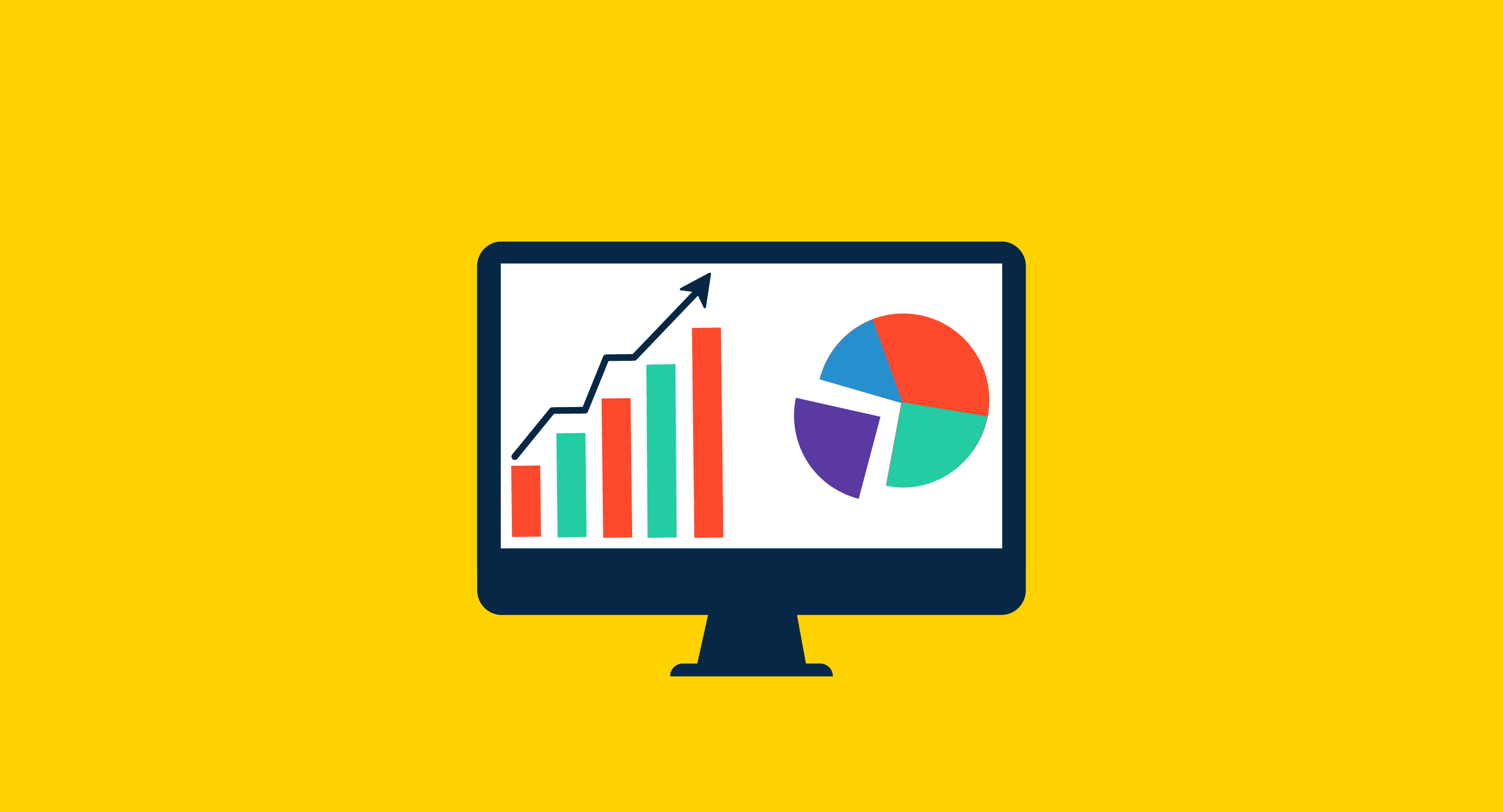Insight gathered from customer data is the key that unlocks the door to performing better as a business.
Marketing with more appeal. Selling with more vigor. Solving customer problems more efficiently. All of those business actions can be done better with data.
Every software program your business uses is likely filled to the brim with data, ripe and ready to be analyzed to unleash actionable insights. When it comes to finding ways to improve your selling processes and customer relationships, your customer relationship management (CRM) software will provide all the information you should need.
CRM analytics, also known as customer analytics, refers to the process of interpreting the data within your CRM software to uncover valuable insights that will impact business decisions. The overall purpose is to better understand your customers so you can sell to them as effectively as possible.
It’s no secret that it takes more than one positive interaction with a customer to win them over. Earning their loyalty and trust requires understanding - if you don’t have a good idea of who they are, what they want, and the problems they’re trying to solve, then how can you expect to meet their needs?
The sheer amount of data held within your CRM software is a goldmine. While some of it might seem mundane, like contact information and interactions with reps, everything can be used to nurture that mutually beneficial relationship between you and your customers.
While there are specific functions a CRM should provide in order to work well, another side of its functionality is providing data and analytics. Business analytics is the foundation for successfully converting leads into customers and customers into brand advocates.
Here are a couple of examples as to how CRM analytics can make that happen for your business.
CRM analytics has the ability to lay out a clear customer journey for your business to follow and act upon. Every customer goes through a journey, starting when they don’t even know your business exists, to the moment they pay an invoice and become brand advocates.
When buying impulsively, the entire journey happens almost instantly. But when it comes to large purchase decisions, the customer's journey will be significantly longer, include various decision-makers, and require multiple conversion points. For example, if a business is thinking about investing in a new software tool, they would conduct primary research, collect and review proposals, and consult key stakeholders.
When dealing with a process that can take months, it’s important to have software in place that can give sales and marketing team members the ability to manage the customer's journey all the way to close (and beyond). The right CRM software will look at the areas of the customer journey where buying signals occur and track key metrics that a business needs to understand satisfaction rates. These data points are then analyzed to reveal methods that businesses can implement to improve their processes for selling and nurturing customer relationships.
As pointed out in the examples above, there are key indicators in the process of a buyer's journey that indicate a desire to move from disinterest to purchasing your product or service. This transition is mirrored in any type of customer transaction.
Your CRM should provide easy access to analytics dashboards and reporting features that showcase these indicators and how they impact the business and forecasting. When a business is considering purchasing a solution, the seller’s CRM should track key items like website visits, touchpoints, social media engagements, if forms are filled out, if webinars or other events were attended, and more.
On their own, these items might not mean anything, but the right analytics will show trends among certain customers based on the frequency or significance of their engagement.
CRM analytics can also provide insight into customer satisfaction by picking up both positive and negative signals based on their actions.
Tracking things like open cases, inbound and outbound calls, and conversation subject matter can all reveal if a certain customer is getting their money’s worth, or running into issue after issue. A customer opening a case to complain about a product issue sends an entirely different signal than a customer using that same form to renew their contract.
Both actions require a response from your team, but different types. In the first situation, your team needs to make it right through customer service. In the second situation, your team could follow up with opportunities to upsell or cross-sell. Either way, analyzing those signals will offer data that assists in making efforts to further satisfy or retain customers.
Another way CRM analytics can help your business is through predictive modeling, which is the process of predicting outcomes using data. By analyzing custom data, businesses can accurately determine the likelihood of success or failure of a future endeavor. Essentially, it offers a glimpse into the future should a certain action be taken, allowing businesses to mitigate the associated risks.
To use predictive modeling effectively, a company must have access to as much customer data as possible - analyzing the results of interactions from 100 customers is a lot more effective and insightful than doing the same thing with just three. Luckily, your CRM holds all of the information you should need to unlock those insights.
Last but not least, CRM analytics can help your business divide customers into different segments.
Especially if your business is still in the process of scaling up to where you want it to be, you might be thinking that you only have one customer base - the one that buys your solution. While they all have that one trait in common, splitting them up further and putting them into different buckets can help you sell to them more efficiently.
Using CRM analytics to group customers together based on traits and actions, like the customer’s role, industry, purchasing history, and support requests can help you market your product and sell to them better.
Reaping the benefits of CRM analytics requires more than just using a customer relationship management tool. The data it holds must be continuously collected, tracked, and managed.
These business processes are more than just the technical functions of the software you use. When starting with CRM data management and analytics, you need to start by educating users and implementing automation where possible.
Employees are the most valuable tool in CRM implementation. The best software in the world is only as good as the people using it. Training employees on data management, proper use of the software, and the sales and marketing processes it serves is a must.
Employees and management also need to be trained in data and analytics reports. Their training needs to demonstrate how the information they have can help them better serve current customers, gain new customers, and ultimately earn more business.
Without a good understanding of how the data will be used, users might start cluttering your CRM with invaluable data. Avoid this by defining workflows, establishing processes, and make it clear what “good data” looks like within a CRM.
When educating your employees, make sure there is an emphasis on cross-departmental communication and collaboration. Sales is not the only department that contributes to attracting and retaining customers. Marketing and customer service play a serious role as well.
Max van den Ingh
Head of Growth at POP
A key factor in managing CRM data is implementing automation wherever you can. Human error happens - details are missed, data is entered incorrectly, and account information can fall out of date. Not only can automation help you avoid these mistakes, but it also opens up a lot more time for sales reps to focus on the customer at hand, rather than their data.
While your business’s automation needs are unique, these actions should be designed to reduce the steps that occur within a customer interaction. If a customer fills out a form on your website signifying they need help, automation should take the form from the website, record the request under the customer's file in your CRM, and send a notification to that rep alerting them that action is required.
The dashboards you use to deliver this information are incredibly important. Customer information has a large impact on the sales and service process, so the data contained in the dashboard needs to be properly interpreted by everyone involved.
Your CRM analytics dashboard is the go-to place for information for customer-facing departments. It’s crucial to ensure that it’s displaying key data points that will guide those departments as they navigate customer relationships.
If you’re looking for some guidance on the data points to track with your CRM analytics dashboard, here are some metrics to focus on both before and after a sale is made.
Similar to the tasks you automate, the metrics you track will be unique to your business,current goals, and objectives. You might add some more along the way, but this list is a good place to start.
Presale activities include every action you take in an effort to close a deal. Tracking the list of metrics below and noticing upward or downward trends over time is important in finding ways to improve your selling strategy.
New prospects: The number of new leads that have been entered into the sale funnel. This metric shows how effectively your business fuels your sales pipeline and will include activities like the number of cold calls made or emails sent.
New opportunities: The number of leads that have been qualified as opportunities, or someone who is likely to purchase your solution. This will not only help predict how many deals you might close (once conversion rates are taken into account), but it will also show the effectiveness of your lead qualification methods.
Value demonstrations: The number of value demonstrations that are performed by sales reps. Comparing this to the number of deals closed will help in calculating your conversion rate.
Customer interactions: The total number of touchpoints you have had with each customer. This includes everything from initial outreach to sending over a proposal.
Once the sale is made (congrats!), you now have a new customer relationship to focus on. To do so effectively, you can focus on the following post-sale metrics.
Customer service requests: The number of times a customer has to request support from a sales rep or customer service agent. This metric can reveal common problems your customers are having with your solution and how often it’s occurring.
Cross-sells and up-sells: How often you come across a chance to either cross-sell or upsell to your customers. These opportunities are mutually beneficial - your business makes another sale and the customer is given a new solution that will further resolve their pain point.
Churn rate: The rate at which customers stop doing business with your company.
Retention rate: The rate at which you retain customers and gradually start to earn their loyalty. Comparing churn and retention rates can offer insight into how to turn those churned customers into a positive relationship.
Implementing a CRM into your sales strategy is a step in the right direction. However, starting to analyze the data within it using CRM analytics turns that step into a giant leap.
Using the associated data-driven techniques to gain an understanding of your customers and unlock insights into how to sell to them better is beneficial for both parties. Your customers feel valued, and you retain their business. It’s a win-win.
A big part of displaying CRM analytics is using data visualization to make the information easy to digest. Looking for some ideas? Here are 67.
Customers are a difficult breed to please.
 by Ninisha Pradhan
by Ninisha Pradhan
LinkedIn has proven to be the most powerful social media for business people and salespeople.
 by George Rowlands
by George Rowlands
In a world of instant gratification, your customers expect immediate responses to their...
 by Abhishek Agrawal
by Abhishek Agrawal
Customers are a difficult breed to please.
 by Ninisha Pradhan
by Ninisha Pradhan
LinkedIn has proven to be the most powerful social media for business people and salespeople.
 by George Rowlands
by George Rowlands
Never miss a post.
Subscribe to keep your fingers on the tech pulse.




